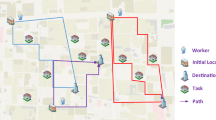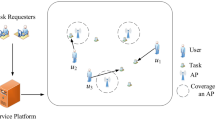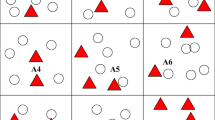Abstract
Wireless Sensor Networks (WSNs) have become essential parts in various smart city projects. However, the application-specific WSN deployment is constrained by its high cost, low flexibility and hard management. To address these limitations, a complementary promising solution, known as mobile crowdsensing, is proposed. Mobile crowdsensing leverages the surge of mobile devices as well as the sensors attached to them to opportunistically and cooperatively conduct sensing tasks. Thanks to the crowdness and mobility of mobile devices, mobile crowdsensing is able to enlarge the sensing scale and granularity. Existing mobile crowdsensing techniques are usually centralized methods and rely on infrastructure communications. Witnessing the development of Device-to-Device (D2D) communications, it is ideal to explore such abilities such that the sensing tasks can be conducted in a distributed manner as well as an infrastructureless way. Via D2D, all participated nodes can directly assign tasks to encountered nodes. In this paper, aided by the encounter relationship among mobile nodes, we study the time minimization task assignment problem in mobile crowdsensing. Specially, we propose offline and online algorithms based on historic encounter information and real-time assigned task execution time, respectively. Real-world trace based experiments validate the efficiency of our proposal.












Similar content being viewed by others
References
Xie S, Wang Y (2014) Construction of tree network with limited delivery latency in homogeneous wireless sensor networks. Wirel Pers Commun 78(1):231–246
Shen J, Tan H, Wang J, Wang J, Lee S (2015) A novel routing protocol providing good transmission reliability in underwater sensor networks. Journal of Internet Technology 16(1):171–178
Zhang Y, Sun X, Wang B (2016) Efficient algorithm for k-barrier coverage based on integer linear programming. China Communications 13(7):16–23
Zeng D, Li P, Guo S, Miyazaki T, Hu J, Xiang Y (2015) Energy minimization in multi-task software-defined sensor networks. IEEE Trans Comput 64(11):1–1
Dutta P, Aoki PM, Kumar N, Mainwaring A, Myers C, Willett W, Woodruff A (2009) Common sense: participatory urban sensing using a network of handheld air quality monitors. In: Proceedings of the 7th ACM conference on embedded networked sensor systems. ACM, pp 349–350
Hull B, Bychkovsky V, Zhang Y, Chen K, Goraczko M, Miu A, Shih E, Balakrishnan H, Madden S (2006) Cartel: a distributed mobile sensor computing system. In: Proceedings of the 4th international conference on embedded networked sensor systems. ACM, pp 125–138
Eriksson J, Girod L, Hull B, Newton R, Madden S, Balakrishnan H (2015) The pothole patrol: using a mobile sensor network for road surface monitoring. ACM, pp 29–39
Weppner J, Lukowicz P (2013) Bluetooth based collaborative crowd density estimation with mobile phones. In: IEEE international conference on pervasive computing and communications. IEEE, pp 193–200
Reddy S, Parker A, Hyman J, Burke J, Estrin D, Hansen M (2007) Image browsing, processing, and clustering for participatory sensing: lessons from a dietsense prototype. In: Emnets 07 Proceedings of Workshop on Embedded Networked Sensors , pp 13–17
Drubin C (2014) Smartphone users worldwide will total 1.75b in 2014. Microw J 57(3):51
Gupta A, Jha RK (2015) A survey of 5g network: architecture and emerging technologies. Access IEEE 3:1206–1232
Guo B, Wang Z, Yu Z, Wang Y, Yen NY, Huang R, Zhou X (2015) Mobile crowd sensing and computing: the review of an emerging human-powered sensing paradigm. ACM Comput Surv 48(1)
Soyata T, Ba H, Heinzelman W, Kwon M, Shi J (2013) Accelerating mobile cloud computing: a survey. Communication Infrastructures for Cloud Computing:175–197
Liu A, Zhang Q, Li Z, Choi YJ, Li J, Komuro N (2016) A green and reliable communication modeling for industrial internet of things. Comput Electr Eng. doi:10.1016/j.compeleceng.2016.09.005
Zeng D, Guo S, Barnawi A, Yu S, Stojmenovic I (2015) An improved stochastic modeling of opportunistic routing in vehicular cps. IEEE Trans Comput 64(7):1819–1829
Zeng D, Guo S, Hu J (2014) Reliable bulk-data dissemination in delay tolerant networks. IEEE Trans Parallel Distrib Syst 25(8):2180–2189
Yao H, Zeng D, Huang H, Guo S (2015) Opportunistic offloading of deadline-constrained bulk cellular traffic in vehicular dtns. IEEE Trans Comput 64(12):3515–3527
Allahverdi A, Ng CT, Cheng TCE, Kovalyov MY (2008) A survey of scheduling problems with setup times or costs. Eur J Oper Res 187(3):985–1032
Wang Z, D Huang HWu, Deng Y (2014) Qos-constrained sensing task assignment for mobile crowd sensing. In: Global communications conference. IEEE, pp 311–316
Fu T, Liu P (2015) Contribution aware task allocation in sensor networks. In: IEEE symposium on computers & communication, pp 549–554
Xiao M, Wu J, Huang L (2015) Home-based zero-knowledge multi-copy routing in mobile social networks. IEEE Trans Parallel Distrib Syst 26(5):1238–1250
Wu J, Wang Y (2012) Social feature-based multi-path routing in delay tolerant networks. In: INFOCOM 2012 proceedings IEEE. IEEE, pp 1368–1376
Ma T, Zhou J, Tang M, Tian Y, Al-Dhelaan A, Al-Rodhaan M, Lee S (2015) Social network and tag sources based augmenting collaborative recommender system. IEICE Trans Inf Syst 98(4):902–910
Yang G, He S, Shi Z (2016) Leveraging crowdsourcing for efficient malicious users detection in large-scale social networks. IEEE Internet of Things Journal:1–10
Tang Z, Liu A, Huang C (2016) Social-aware data collection scheme through opportunistic communication in vehicular mobile networks. IEEE Access 4:6480–6502
Maia SLF, Silva ER, Guardieiro PR (2014) A new optimization strategy proposal for multi-copy forwarding in energy constrained dtns. IEEE Commun Lett 18(9):1623–1626
Song Z, Zhang B, Liu CH, Vasilakos AV, Ma J, Wang W (2014) Qoi-aware energy-efficient participant selection. In: IEEE international conference on sensing, communication, and networking (SECON), 2014 eleventh annual. IEEE, pp 248–256
Song Z, Liu CH, Wu J, Ma J (2014) Qoi-aware multitask-oriented dynamic participant selection with budget constraints. IEEE Trans Veh Technol 63(9):4618–4632
Xu Z, Zhang H, Sugumaran V (2016) Participatory sensing-based semantic and spatial analysis of urban emergency events using mobile social media. EURASIP J Wirel Commun Netw 2016(1):1–9
Xu Z, Zhang H, Hu C, Mei L, Xuan J, Choo K-KR, Sugumaran V, Zhu Y (2016) Building knowledge base of urban emergency events based on crowdsourcing of social media. Concurrency & Computation: Practice & Experience 28(15):4038– 4052
He S, Shin DH, Zhang J, Chen J (2014) Toward optimal allocation of location dependent tasks in crowdsensing. Proceedings - IEEE INFOCOM 5(11):745–753
He S, Shin DH, Zhang J, Chen J (2016) Near-optimal allocation algorithms for location-dependent tasks in crowdsensing. IEEE Trans Veh Technol:1–1
Wen D, Cai Y, Li Z, Fan Y (2013) An incentive compatible two-hop multi-copy routing protocol in dtns. In: IEEE international conference on mobile ad-hoc and sensor networks. IEEE, pp 140–146
Shi C, Lakafosis V, Ammar MH, Zegura EW (2012) Serendipity: enabling remote computing among intermittently connected mobile devices. In: Proceedings of the thirteenth ACM international symposium on mobile ad hoc networking and computing. ACM, pp 145–154
Acknowledgments
This research was supported by the NSF of China (Grant No. 61673354, 61672474, 61402425, 61272470, 61305087, 61440060, 61501412), the Provincial Natural Science Foundation of Hubei (Grant No. 2015CFA065). This paper has been subjected to Hubei Key Laboratory of Intelligent Geo-Information Processing, China University of Geosciences, Wuhan 430074, China. It was also supported by Open Research Project of The Hubei Key Laboratory of Intelligent Geo-Information Processing (KLIGIP201603 and KLIGIP201607).
Author information
Authors and Affiliations
Corresponding author
Rights and permissions
About this article
Cite this article
Yao, H., Xiong, M., Liu, C. et al. Encounter Probability Aware Task Assignment in Mobile Crowdsensing. Mobile Netw Appl 22, 275–286 (2017). https://doi.org/10.1007/s11036-016-0794-5
Published:
Issue Date:
DOI: https://doi.org/10.1007/s11036-016-0794-5




